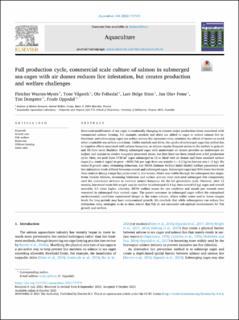| dc.description.abstract | Structural modification of sea cages is continually changing to counter major production issues associated with commercial salmon farming. For example, snorkels and skirts are added to cages to reduce salmon lice infestations, and submerging cages can reduce salmon-lice encounter rates, minimise the effects of storms or avoid other unsuitable sea surface conditions. Unlike snorkels and skirts, the uptake of submerged cages has stalled due to negative effects associated with salmon buoyancy, as salmon require frequent access to the surface to gulp air and fill their swim bladders. Fitting submerged cages with underwater air domes provides an underwater air surface and appears to resolve buoyancy associated issues, but they have not been tested over a full production cycle. Here, we used three 1728 m3 cages submerged to 15 m fitted with air domes and three standard surface cages (i.e. control cages) to grow ~6000 fish per cage from sea transfer (~ 0.2 kg) to harvest size (~5 kg). We tested if growth rates, swimming behaviour, key SWIM (Salmon Welfare Index Model) welfare parameters and lice infestation levels differed between control and submerged cages. Submerged cages had 93% lower lice levels than controls during a large lice pulse event in mid-winter, which was visible through the subsequent lice stages. Swim bladder fullness, swimming behaviour and surface activity rates indicated submerged fish competently used the underwater airdome to maintain neutral buoyancy for the full production cycle. However, after 12 months, harvested mean fish weight was far smaller in submerged (2.8 kg) than control (5 kg) cages and overall mortality 2.5 times higher. Likewise, SWIM welfare scores for eye condition and mouth jaw wounds were worsened in submerged than control cages. The poorer outcomes in submerged cages reflect the suboptimal environmental conditions experienced deeper in the water column, where colder water and/or lower oxygen levels for long periods may have compromised growth. We conclude that while submergence can reduce lice infestation rates, strategies to do so must ensure that fish do not encounter sub-optimal environments for fish growth and welfare. | en_US |
